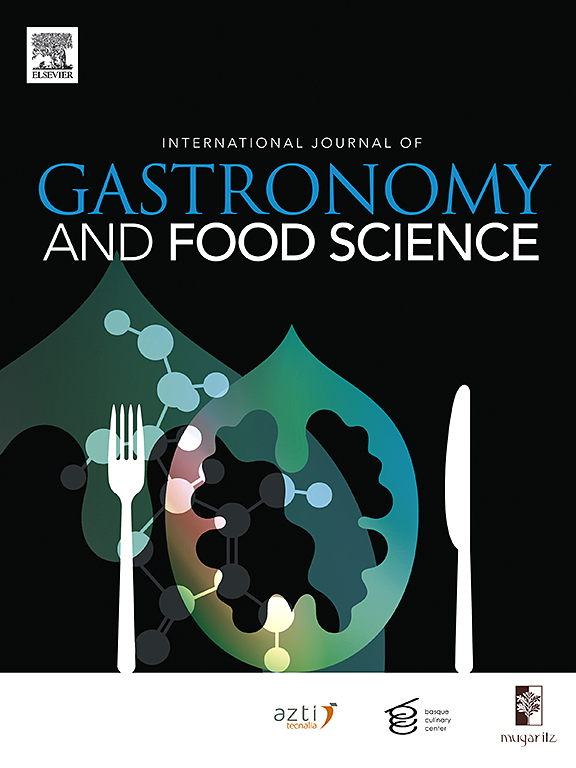Spirulina as a food supplement in the 3D printing of meat analogs
IF 3.2
2区 农林科学
Q2 FOOD SCIENCE & TECHNOLOGY
International Journal of Gastronomy and Food Science
Pub Date : 2025-04-02
DOI:10.1016/j.ijgfs.2025.101176
引用次数: 0
Abstract
The increased consumption of animal-based proteins has raised environmental concerns due to adverse impacts such as greenhouse gas emissions and intensive use of natural resources. The transition to a more plant-based diet is recognized as an effective solution to mitigate these impacts, and meat analogs are considered promising due to their physical, chemical, functional, sensory, and nutritional properties. These substitutes include restructured plant-based products, vegetables, and innovations. Spirulina biomass emerges as a promising raw material to produce meat analogs, as it is certified safe and considered a complete food due to its content of proteins, essential amino acids, minerals, and vitamins. 3D printing technology plays a crucial role in this transition, offering a variety of plant-based alternatives and allowing for the customization of geometries, structures, and food compositions. This article aims to explore the potential of 3D printing in the formulation of plant-based foods, with an emphasis on the incorporation of Spirulina as a food supplement. The research reveals the diversity of alternative protein sources, such as vegetables, restructured plant-based products, innovations with different vegetables and microalgae. Spirulina biomass is noteworthy for its safety certification and comprehensive nutritional profile. Technology, especially 3D printing, plays a crucial role in the production of these analogs, allowing customization and innovation in food composition. However, the challenges indicate the need for further studies and the combination of vegetable proteins to achieve a texture suitable for consumers. Exploring synergies with different protein sources is vital to broadening product diversity and improving consumer acceptance. The use of Spirulina in the 3D printing of meat analogs stands out as a promising alternative, offering nutritional, functional, sensory, and environmental benefits. Despite the technological challenges, the potential of this approach in creating plant-based products can meet sustainable and innovative food demands, representing a revolution in the food industry towards healthier, more personalized, and attractive foods.

螺旋藻作为食品补充剂在3D打印肉类类似物
由于温室气体排放和自然资源的密集使用等不利影响,动物性蛋白质消费的增加引起了对环境的关注。向更多植物性饮食的转变被认为是减轻这些影响的有效解决方案,而肉类类似物因其物理、化学、功能、感官和营养特性而被认为是有前途的。这些替代品包括重组的植物性产品、蔬菜和创新产品。螺旋藻生物质是一种很有前途的生产肉类类似物的原料,因为它被认证为安全的,并且由于其蛋白质、必需氨基酸、矿物质和维生素的含量而被认为是一种完整的食物。3D打印技术在这一转变中起着至关重要的作用,它提供了各种基于植物的替代品,并允许定制几何形状、结构和食物成分。本文旨在探讨3D打印在植物性食品配方中的潜力,重点是将螺旋藻作为食品补充剂。这项研究揭示了替代蛋白质来源的多样性,比如蔬菜、重组的植物性产品、不同蔬菜和微藻的创新。螺旋藻生物量值得注意的是其安全认证和全面的营养概况。技术,特别是3D打印,在这些类似物的生产中起着至关重要的作用,允许定制和创新食品成分。然而,这些挑战表明需要进一步的研究和植物蛋白的组合,以达到适合消费者的质地。探索与不同蛋白质来源的协同作用对于扩大产品多样性和提高消费者接受度至关重要。在肉类类似物的3D打印中使用螺旋藻作为一种有前途的替代品,提供营养,功能,感官和环境效益。尽管存在技术挑战,但这种方法在创造植物性产品方面的潜力可以满足可持续和创新的食品需求,代表着食品工业向更健康、更个性化和更有吸引力的食品的革命。
本文章由计算机程序翻译,如有差异,请以英文原文为准。
求助全文
约1分钟内获得全文
求助全文
来源期刊

International Journal of Gastronomy and Food Science
Social Sciences-Cultural Studies
CiteScore
5.30
自引率
10.50%
发文量
170
审稿时长
45 days
期刊介绍:
International Journal of Gastronomy and Food Science is a peer-reviewed journal that explicitly focuses on the interface of food science and gastronomy. Articles focusing only on food science will not be considered. This journal equally encourages both scientists and chefs to publish original scientific papers, review articles and original culinary works. We seek articles with clear evidence of this interaction. From a scientific perspective, this publication aims to become the home for research from the whole community of food science and gastronomy.
IJGFS explores all aspects related to the growing field of the interaction of gastronomy and food science, in areas such as food chemistry, food technology and culinary techniques, food microbiology, genetics, sensory science, neuroscience, psychology, culinary concepts, culinary trends, and gastronomic experience (all the elements that contribute to the appreciation and enjoyment of the meal. Also relevant is research on science-based educational programs in gastronomy, anthropology, gastronomic history and food sociology. All these areas of knowledge are crucial to gastronomy, as they contribute to a better understanding of this broad term and its practical implications for science and society.
 求助内容:
求助内容: 应助结果提醒方式:
应助结果提醒方式:


